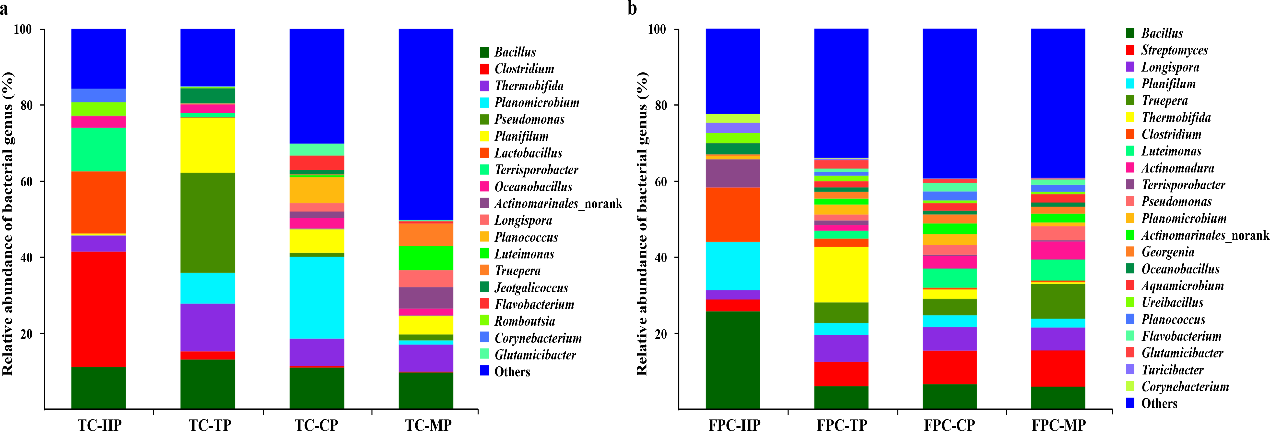Lignocellulose in organic solid waste is a class of recalcitrant organic carbon with complex structure and stable chemical properties. Phenolic compounds, the intermediate products of lignin degradation, are important precursors of humic acid (HA) synthesis and affect the chemical structure and properties of HA. The migration, transformation and fate of phenolic compounds in composting and their effects on the formation of HA functional groups are not clear at present. In previous studies, our team found that the brown rot fungus Gloeophyllum trabeum can modify lignin through extracellular Fenton reaction to produce a large number of small molecular phenolic compounds. In the present research, we used different methods of G. trabeum inoculation to study organic carbon conversion and phenolic compound turnover during organic solid waste composting. The goals of this work were: (i) to discriminate the individual contribution of major phenolic compounds to the formation of HA functional groups, (ii) to reveal the response of functional bacterial community and phenol oxidoreductases to phenolic compounds and (iii) to identify the key microbial groups involved in the humification of phenolic compounds. This study provides insights into the mechanism of HA formation driven by phenolic compounds from the perspective of microbiology.
Compared with the control treatment (CT), the degradation rate of cellulose, hemicellulose and lignin in G. trabeum treatment (GT) increased by 181%, 49% and 109%, respectively (Fig. 1a-c), and HA content was increased by 16% (Fig. 1d). This result showed that G. trabeum treatment accelerated the humification process of lignocellulose during composting. Meanwhile, the activities of manganese peroxidase (MnP) and laccase (Lac) in GT treatment were also significantly increased (Fig. 1e&f).

Fig. 1 Changes of lignocellulose, humic acid and oxidoreductase during composting
Phenolic compounds in the composting process were identified and quantitatively analyzed by HPLC-MS (Fig. 2a). Most of the phenolic compounds displayed significantly decreased concentrations in the process of composting and participated in the formation of HA as precursors. In GT treatment, the conversion rates of caffeic acid, p-hydroxybenzoic acid, ferulic acid, chlorogenic acid and erucic acid were higher than those in control. Solid-phase 13C NMR was applied to determine the carbon distribution of functional groups in HA from CT and GT in different composting phases. The contents of phenol C and aryl C in GT increased over the composting process and were significantly higher than those in control (Fig. 2b). The aromatization index of HA in the final products of GT composting was significantly higher than that of control. The results indicated that G. trabeum modification could promote the transformation of phenolic compounds to form structurally stable HA and increase the content of aromatic groups in HA.

Fig. 2 Changes in phenolic compounds and humic acid functional groups and their correlation during composting (c: CT, d: GT)
To investigate the influence of G. trabeum modification on the relationship between phenolic compounds and HS chemical structure, Pearson correlation analysis was performed between phenolic compounds and functional groups of HA (Fig. 2c&d). Significant correlations between gallic acid, chlorogenic acid, gentisic acid, benzoic acid, p-coumaric acid and specific functional groups were only identified in GT (Fig. 2c). In addition, the correlations between p-hydroxybenzoic acid and aryl C, benzoic acid and phenol C, phthalic acid and carboxyl C, syringic acid and aryl C and phenol C were significantly stronger in GT (P < 0.01) (Fig. 2c) compared to CT (P < 0.05) (Fig. 2d). The significant correlations between phenolic compounds and phenolic, carboxyl and aromatic groups in GT treatment highlighted the important role of these phenolic compounds in the formation of HA functional groups.
Microbial community structure analysis showed that Bacillus and Streptomyces in GT treatment was the dominant bacterial genus in the early and late stage of composting, respectively (Fig. 3). The two bacterial genera promoted the oxidation of phenolic compounds into HA monomers by producing laccases, which was responsible for the enhanced HA synthesis in GT treatment. Redundancy analysis (RDA) showed that there was a significant correlation between phenolic compounds and bacterial community in GT treatment. Variance decomposition analysis (VPA) further confirmed that G. trabeum modification enhanced the influence of phenolic compounds on the succession of bacterial community structure (Fig. 4). These results provide a scientific basis for understanding the process and mechanism of HA formation in composting, and support the development of organic solid waste utilization technology based on HA synthesis regulation.

Fig. 3 Bacterial community succession during composting (a: CT, b: GT)

Fig. 4 Relationship between bacterial community, phenolic compounds and environmental factors during composting (a&c: CT, b&d: GT)
The research has been published in Bioresource Technology and Journal of Cleaner Production. The first author is Associate Professor Ning Zhu and the corresponding author is Professor Hongmei Jin of Institute of Agricultural Resource and Environmental Science. The research is supported by National Natural Science Foundation of China (51908255), Natural Science Foundation of Jiangsu Province (BK20180301) and Jiangsu Agricultural Science and Technology of Innovation Fund (CX(19)3092).


